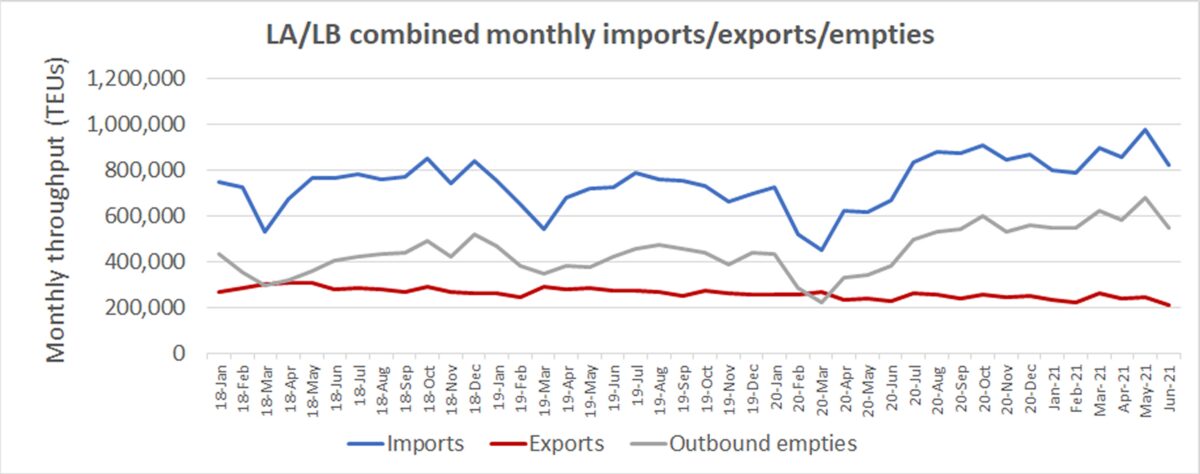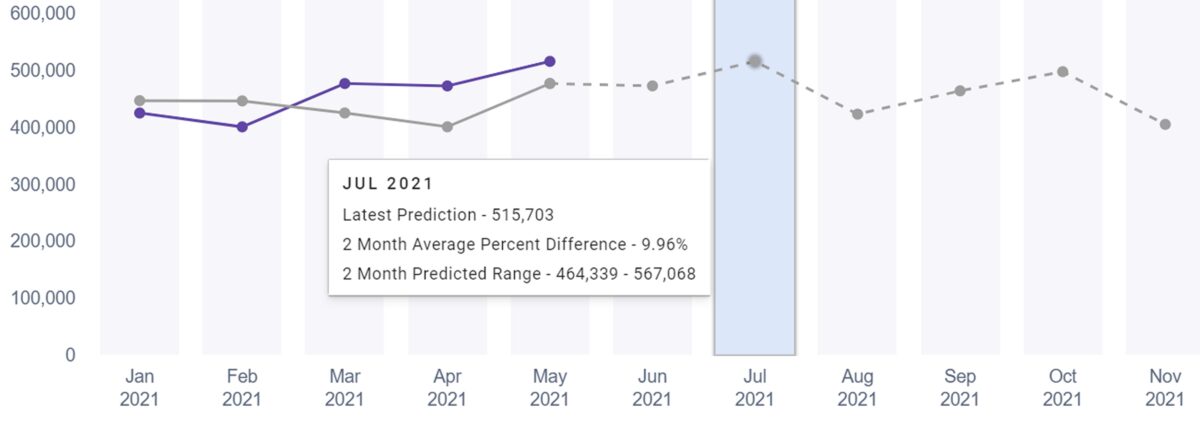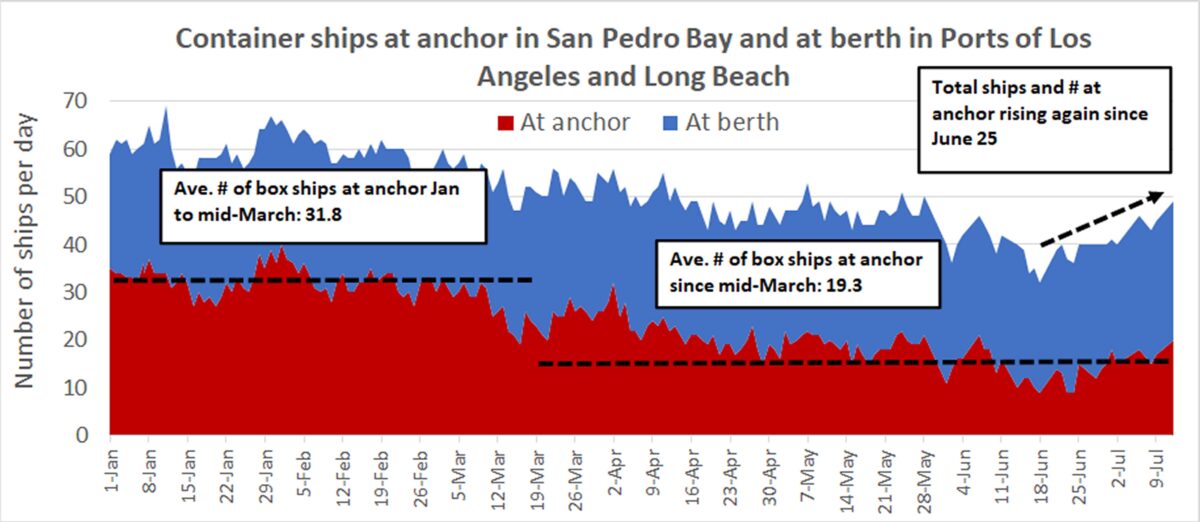The Port of Los Angeles announced its best June numbers ever on Wednesday, capping off its best quarter ever. Volumes are even higher in July and the number of container ships at anchor in San Pedro Bay — the so-called “parking lot” — is on the rise yet again.
“Cargo continues to move at a record pace. There’s no lull in the action, no half-time intermissions,” said Port of Los Angeles Executive Director Gene Seroka.
Yantian fallout (temporarily) pares numbers
There may not have been a full-fledged half-time break, but there was a fleeting time-out from rising imports in June courtesy of COVID restrictions at the port of Yantian, China, which temporarily cut flows to California.
The Port of Los Angeles reported total June volume including loaded imports, loaded exports and empties of 876,430 twenty-foot equivalent units, down 13% from the all-time monthly high of 1 million TEUs in May. Last month’s imports came in at 476,763 TEUs, also down 13% from May.
This mirrors the pattern seen in Long Beach. Loaded import containers to Long Beach declined 20% in June versus May.

According to Seroka, “About a third of all vessel services that call here originate from the Guangdong Province [where the Yantian port is located] and vessel arrivals here slowed somewhat in June as the Guangdong Province operated at about 50% of normal ship departure capacity.”
The looming challenge for California’s ports is that all the cargo that didn’t come last month is now belatedly arriving. “The South China seaports resumed full operations late in the month of June, which means more ships are starting to head our way this month and into August,” Seroka noted.
July, August look ‘super-strong’
Not only must all the delayed Yantian cargo be handled, but the traditional peak season will simultaneously ramp up. “July and August look super-strong … and all signs point to a busy second half of 2021,” said Seroka.
“We’re now seeing seasonal items such as back-to-school, fall fashion and Halloween goods start to make their way in and we do expect some cargo owners to bring in year-end holiday products a little earlier than normal.”
The port unveiled a predictive tool on Wednesday called the Port of Los Angeles Horizon that uses algorithms to estimate future volumes.
Port of Los Angeles Horizon indicates total July volumes (imports, exports, empties) of between 950,000 and 1 million TEUs — flirting with the monthly record — and August volumes well above 900,000 TEUs. The predictive tool estimates that July imports will be 515,703 TEUs.

For full-year 2021, the port expects to handle around 10.5 million TEUs, 14% above the previous high-water mark reached in 2020.
Dwell time woes persist
Los Angeles is heading into the next phase of the surge amid ongoing hurdles to cargo flows. “We have to continue to squeeze out every ounce of efficiency,” Seroka emphasized. “Now all of our supply chain partners need to step up to further improve throughput and velocity.”
Container dwell time at terminals “continues to hover near its peak of five days,” he reported. “On-dock rail time is running at about 12 days, not far from its peak in the spring. And with warehouses filled to the rafters, street dwell times ran as high as eight days in June. The bottom line is that the continued surge has strained all nodes of the U.S. supply chain and we must change these trends.”
On a positive note, only half of ships arriving in Los Angeles went straight to anchor last month, “down significantly from 90% of ships going straight to the parking lot in February,” said Seroka, adding, “It was the lowest percentage since last October, when ships first started heading to anchor.” The average wait time at anchor fell to five days in June, down from a peak of eight days in March.
But the number of ships at anchor has been rising again since late June. “We’re seeing a few more ships at anchor now, likely tied to the additional vessels that started coming once folks got healthy in Yantian and other ports in Guangdong Province,” said Seroka.
According to data from the Marine Exchange of Southern California, the total number of container ships in the port complex (at berths in Los Angeles and Long Beach as well as at anchor in San Pedro Bay) rose back to 49 on Monday. The number of ships at anchor rose to 20. These are double the number of total ships in the port complex and at anchor in the third week of June, when calls were being curbed by the Yantian fallout.

Import demand signals look strong
The anchorage numbers could continue to climb. Vessel tracking data from MarineTraffic shows a caravan of at least three dozen container ships currently en route from China to the U.S.

Meanwhile, the FreightWaves SONAR proprietary index of cargo bookings for Chinese goods bound for the U.S. remains near its high in mid-July, implying continued high import volumes into next month.

It has been widely predicted that Americans will reduce their goods consumption as more are vaccinated and spend more on services. It hasn’t happened yet. The retail inventory-to-sales ratio (excluding vehicles and auto parts) remains near its all-time low despite higher non-goods spending.
“It continues to be clear that U.S. consumer spending remains strong,” affirmed Seroka. “Even with a return to service-sector spending on travel, restaurants and ball games, retail sales and e-commerce remain robust.”
Click for more articles by Greg Miller
Related articles:
- Port of Yantian productivity rapidly improves but export delays persist
- Mounting evidence that container crunch will persist into 2022
- California’s massive container-ship traffic jam is still really jammed
- Home Depot has it’s own ship. That’s an ominous sign
- Time to start prepping for Christmas shipping capacity crunch
- Inside container shipping’s COVID-era money-printing machine








What's happening now
Foreign black people are driving down the interstate in a New freightliner condo and a new 53 foot trailer with black magic marker writing on the door or side of the sleeper. Slapping cars and parking their truck in the middle of the interstate with their lights off at night trying to get someone to rear end them . One said he only been in this country for 3 weeks . They never went to truck driving school in the US. And got a cdl.